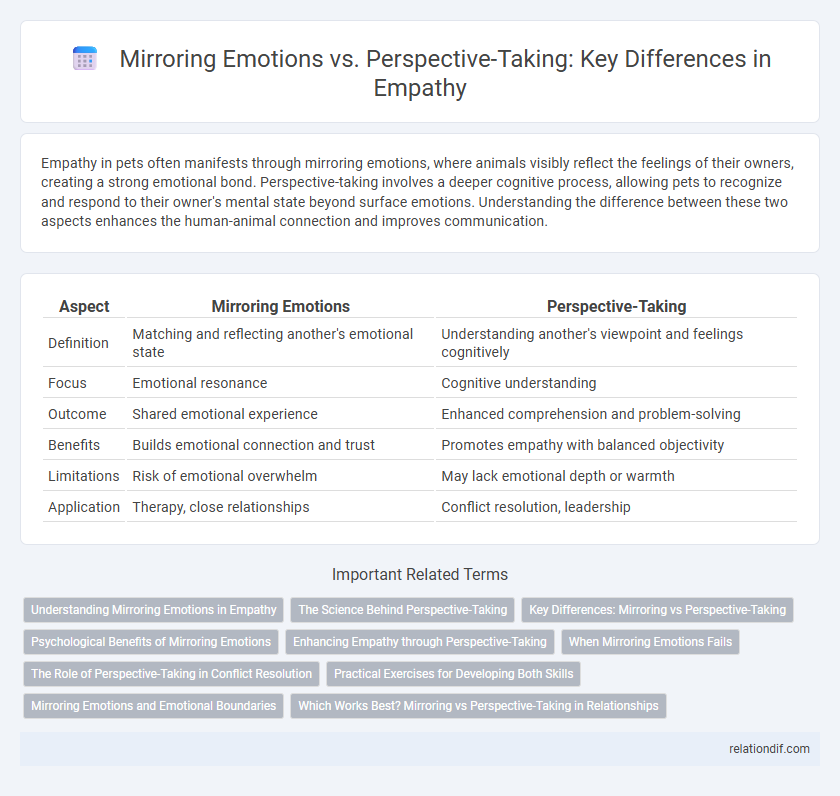Empathy in pets often manifests through mirroring emotions, where animals visibly reflect the feelings of their owners, creating a strong emotional bond. Perspective-taking involves a deeper cognitive process, allowing pets to recognize and respond to their owner's mental state beyond surface emotions. Understanding the difference between these two aspects enhances the human-animal connection and improves communication.
Table of Comparison
| Aspect | Mirroring Emotions | Perspective-Taking |
|---|---|---|
| Definition | Matching and reflecting another's emotional state | Understanding another's viewpoint and feelings cognitively |
| Focus | Emotional resonance | Cognitive understanding |
| Outcome | Shared emotional experience | Enhanced comprehension and problem-solving |
| Benefits | Builds emotional connection and trust | Promotes empathy with balanced objectivity |
| Limitations | Risk of emotional overwhelm | May lack emotional depth or warmth |
| Application | Therapy, close relationships | Conflict resolution, leadership |
Understanding Mirroring Emotions in Empathy
Mirroring emotions in empathy involves subconsciously replicating another person's emotional state, allowing for an immediate and visceral connection to their feelings. This process activates mirror neurons in the brain, which help individuals internally simulate and experience the emotions observed in others. Understanding mirroring emotions is crucial for fostering authentic empathy, as it lays the foundation for recognizing and resonating with another's emotional experience before consciously engaging in perspective-taking.
The Science Behind Perspective-Taking
Perspective-taking activates brain regions such as the temporoparietal junction and medial prefrontal cortex associated with Theory of Mind, enabling individuals to understand others' mental states beyond mere emotional mirroring. Neuroscientific studies reveal that this cognitive process recruits higher-order executive functions, distinguishing it from automatic emotional contagion. These findings underscore perspective-taking's role in fostering deeper social cognition and effective interpersonal communication.
Key Differences: Mirroring vs Perspective-Taking
Mirroring emotions involves directly reflecting another person's feelings to create an immediate emotional connection, enhancing empathy through shared experience. Perspective-taking requires cognitively stepping into someone else's situation to understand their thoughts and motivations beyond just emotions. The key difference lies in mirroring's emotional resonance versus perspective-taking's deeper cognitive understanding of another's viewpoint.
Psychological Benefits of Mirroring Emotions
Mirroring emotions fosters immediate emotional resonance, enhancing interpersonal connections through subconscious synchronization of feelings. This process activates mirror neurons, promoting empathy and emotional validation, which can reduce stress and increase social bonding. Psychological benefits include heightened emotional awareness, improved communication, and strengthened trust in relationships.
Enhancing Empathy through Perspective-Taking
Enhancing empathy through perspective-taking involves actively imagining another person's thoughts and feelings, which fosters deeper emotional understanding beyond mere mirroring of emotions. Research shows that perspective-taking engages cognitive processes that enable individuals to appreciate diverse viewpoints and reduce bias. This method builds stronger social connections and promotes effective communication by encouraging empathetic responses based on insight rather than imitation.
When Mirroring Emotions Fails
Mirroring emotions can fail when it leads to emotional contagion, overwhelming the empathizer and hindering effective support. Unlike perspective-taking, which involves cognitively understanding another's experiences, emotional mirroring risks blurring personal boundaries and increasing stress. Research in social neuroscience highlights that successful empathy balances mirroring emotional states with maintaining emotional regulation and cognitive distance.
The Role of Perspective-Taking in Conflict Resolution
Perspective-taking plays a crucial role in conflict resolution by enabling individuals to understand and internalize the experiences and viewpoints of others, which reduces misunderstandings and promotes empathy. Unlike mirroring emotions that reflect feelings superficially, perspective-taking fosters deep cognitive empathy by encouraging active consideration of others' thoughts and motivations. This cognitive shift enhances communication, facilitates compromise, and supports the development of mutually acceptable solutions in conflicts.
Practical Exercises for Developing Both Skills
Practicing mirroring emotions involves actively observing and reflecting another person's feelings through body language and verbal cues to build rapport and emotional connection. Perspective-taking exercises encourage stepping into someone else's shoes by imagining their thoughts and circumstances, enhancing cognitive empathy and reducing bias. Combining role-playing scenarios with mindful listening drills strengthens both emotional resonance and intellectual understanding, improving overall empathetic communication.
Mirroring Emotions and Emotional Boundaries
Mirroring emotions involves directly reflecting another person's feelings to foster connection, but maintaining emotional boundaries is crucial to avoid emotional burnout and preserve individual wellbeing. This process enhances empathy by validating others' experiences without internalizing their emotional states. Effective emotional mirroring requires awareness of one's limits, ensuring support remains compassionate yet self-protective.
Which Works Best? Mirroring vs Perspective-Taking in Relationships
Perspective-taking fosters deeper understanding in relationships by allowing individuals to grasp others' thoughts and feelings beyond surface emotions, leading to more meaningful connections. Mirroring emotions can create immediate emotional resonance but risks reinforcing negative feelings without critical insight. Studies reveal that combining perspective-taking with selective emotional mirroring produces the most effective empathy, enhancing communication and relationship satisfaction.
mirroring emotions vs perspective-taking Infographic

 relationdif.com
relationdif.com